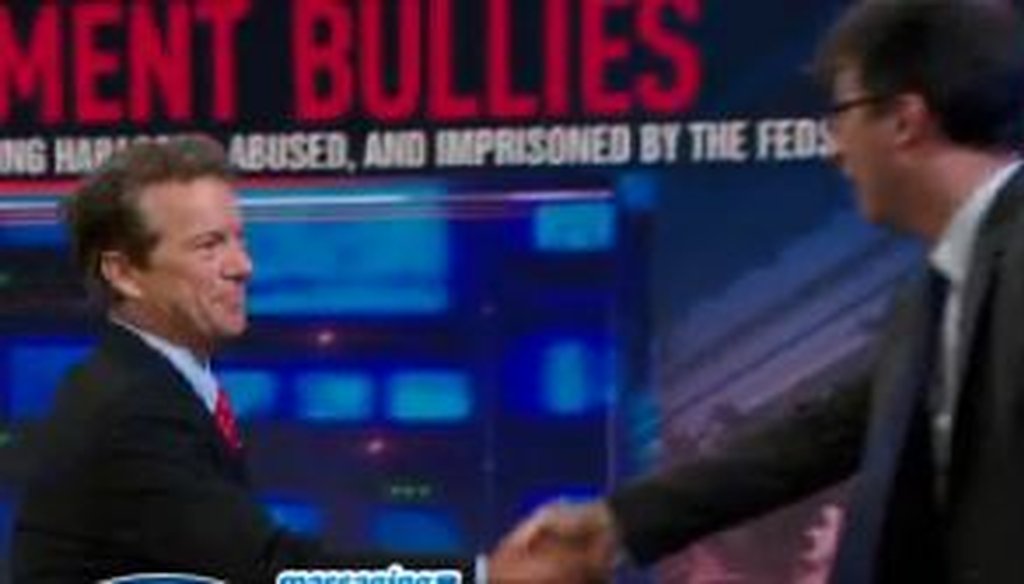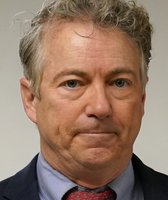Stand up for the facts!
Our only agenda is to publish the truth so you can be an informed participant in democracy.
We need your help.
I would like to contribute

Sen. Rand Paul, R-Ky., discussed health insurance policy with John Oliver on "The Daily Show."
Rand Paul says young people are a major part of the uninsured population
During a recent appearance on The Daily Show, guest host John Oliver and Sen. Rand Paul, R-Ky., engaged in a lively exchange on health insurance. In the interview, Paul said many of the uninsured are young people.
Paul, an eye surgeon, strongly opposed President Barack Obama’s health care law. During the interview, Oliver pressed him on how to get more Americans signed up for insurance.
Paul told Oliver that according to the most recent statistics, "85 percent of people had insurance, so 15 percent didn't. So what you need to do is look at who are the 15 percent, and why don't they have insurance? Of the 15 percent who didn't have insurance, half of them made more than $50,000 a year. Why didn't they buy insurance? Because of the expense. They were young healthy people."
In this item, we’ll check whether the uninsured are predominantly young. In separate items, we’ll look at whether cost of insurance is the biggest barrier to uninsured Americans and whether half of the uninsured made more than $50,000 a year.
We’ll start by noting that it’s tricky to interpret Paul’s phrasing. One interpretation is that he said uninsured Americans making at least $50,000 are primarily young. Another is that he means that uninsured Americans are disproportionately young, regardless of income level. We didn't get an answer from Paul's staff about which of these he had intended, so we’ll look at both scenarios.
Before doing that, we’ll note that the age of uninsured Americans is important because young people have particular insurance needs that are distinct from those of middle-aged and older Americans.
Since young people tend to be healthy, they are more likely to be tempted by the option of not buying insurance, particularly if they do not work for a company that offers subsidized insurance. Many young people are averse to paying for the kind of comprehensive coverage attractive to middle-aged Americans and those with families, since young, healthy people aren’t necessarily going to the doctor very often.
And this makes it harder to devise policies that push younger people into buying insurance.
As Paul put it in the interview, "They don't need low deductibles. They need very high deductibles. They need insurance for catastrophes, because young people are unlikely to get ill. They need it for the rare occasion, not the everyday occasion."
Are higher-income uninsured Americans mostly young?
According to Census Bureau data, uninsured Americans with family incomes above $50,000 break down as follows:
Children up to 18: 17 percent of all uninsured Americans with incomes above $50,000
Ages 19 to 29: 27 percent of all uninsured Americans with incomes above $50,000
Ages 30-39: 17 percent of all uninsured Americans with incomes above $50,000
Ages 40-64: 38 percent of all uninsured Americans with incomes above $50,000
(Anyone 65 and older automatically gets Medicare and thus cannot be uninsured. This census data was calculated and provided to PolitiFact by the liberal Center for Budget and Policy Priorities.)
So about one-quarter of the better-off uninsured are age 19 to 29 -- the age range most people probably think of when they hear the phrase "young" in the context of health insurance. Using a broader age range -- from 19 to 39 -- the share rises to 44 percent. That’s a significant percentage, but it’s short of a majority.
Are uninsured Americans overall mostly young?
Here’s how uninsured Americans break down by age, according to a Kaiser Family Foundation analysis of Census Bureau data:
Age 0-18: 15.9 percent of all uninsured Americans
Age 19-25: 17.3 percent of all uninsured Americans
Age 26-34: 21.4 percent of all uninsured Americans
Age 35-44: 17.5 percent of all uninsured Americans
Age 45-54: 16.4 percent of all uninsured Americans
Age 55-64: 11.5 percent of all uninsured Americans
So, the percentage of the uninsured who are between ages 19 and 25 is 17.3 percent, while the percentage of the uninsured who are between 19 and 34 is 38.7 percent. That means that "young" Americans comprise a significant minority of the uninsured population, though still not a majority.
That said, younger people are statistically more likely to be uninsured than either children or middle-aged Americans. Here are the percentages of people in specific age ranges who are uninsured:
Age 0-18: 9.7 percent of people in this age range are uninsured
Age 19‐25: 27.9 percent of people in this age range are uninsured
Age 26‐34: 27.8 percent of people in this age range are uninsured
Age 35‐44: 21.2 percent of people in this age range are uninsured
Age 45‐54: 17.9 percent of people in this age range are uninsured
Age 55‐64: 14.6 percent of people in this age range are uninsured
In other words, if you’re a young person, you are more likely to be uninsured than children or middle-aged Americans are. However, if you look at uninsured Americans in the big picture, young people are not the biggest part. Children and middle-aged Americans, combined, account for a larger share of the uninsured population.
Our ruling
Paul said that many uninsured Americans are "young." He’s right that significant numbers of young people lack insurance, and that young people are statistically more likely to be uninsured than either children or middle-aged Americans are. However, it’s worth noting that within the universe of uninsured Americans, young people are not close to a majority. Collectively, children and the middle-aged account for a greater share of the uninsured. On balance, we rate Paul’s comment Mostly True.
Our Sources
Rand Paul, interview on Comedy Central’s The Daily Show, Aug. 12, 2013
Kaiser Family Foundation, "The Uninsured: A Primer," October 2012
Employee Benefit Research Institute, "Sources of Health Insurance and Characteristics of the Uninsured: Analysis of the March 2012 Current Population Survey," September 2012
Thomas P. Miller, "What DO We Know About the Uninsured?" July/August 2008
U.S. Census Bureau, press release for "Income, Poverty and Health Insurance Coverage in the United States: 2011," Sept. 12, 2012
U.S. Census Bureau, "Annual Social and Economic (ASEC) Supplement, Table HI01. Health Insurance Coverage Status and Type of Coverage by Selected Characteristics: 2011," accessed Aug. 13, 2013
PolitiFact, "Newt Gingrich says a "large number" of the uninsured make more than $75,000," June 15, 2011
Email interview with Gail Wilensky, former head of Medicare and Medicaid under President George H.W. Bush, Aug. 13, 2013
Email interview with Jonathan Oberlander, health policy professor at the University of North Carolina School of Medicine, Aug. 13, 2013
Email interview with Jonathan Gruber, economist at the Massachusetts Institute of Technology, Aug. 13, 2013
Email interview with Thomas P. Miller, resident fellow at the American Enterprise Institute, Aug. 13, 2013
Email interview with Henry Aaron, senior fellow at the Brookings Institution, Aug. 13, 2013
Email interview with Edwin Park, vice president for health policy at the Center on Budget and Policy Priorities, Aug. 13, 2013
Email interview with Hanns Kuttner, senior fellow at the Hudson Institute, Aug. 13, 2013
Browse the Truth-O-Meter
More by Louis Jacobson
Rand Paul says young people are a major part of the uninsured population
Support independent fact-checking.
Become a member!
In a world of wild talk and fake news, help us stand up for the facts.








































